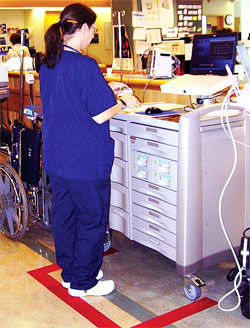Workplace interruptions can kill.

No Interruption Zone around a
medication cart in an ICU (Source)
We’re so used to them that we forget how the incessant disruptions caused by phones, BlackBerries, incoming mails, and coworkers popping in for “just a quick question” are wreaking havoc on our ability to focus and think, with dire results for our productivity and creativity. The problem becomes outright fatal in critical work environments where lack of focus can lead to life threatening mistakes: distracting people like medical staff, airline pilots, or flight controllers can definitely lead to disaster. Then again, even where danger to life is not the issue, the interruptions problem is impacting every workplace, and is costing knowledge intense companies untold millions.
So the question becomes, what can you do about it? You can do many things, of course – and here I want you to learn from what is being tried in those organizations where interruption really can kill.
Stopping the time thieves at the door
If you really want to prevent interruptions by coworkers, you can stop the interrupters the same way you’d stop foxes from entering a chicken coop: by fencing them out!
There are two ways you can ward them off: in situ – by putting a fence around the intended “victims” in their offices – or elsewhere, by sequestering the victims in a safe area away from their usual location.
To protect someone from interruptions in their office, the most effective solution is a door with either a lock or a secretary guarding its other side. Unfortunately, such doors are a rare commodity in this age of open space offices; so cube dwellers need to cordon their cubicle entrance by less hermetic means. A rope or chain with a “Do not Disturb” sign hanging from it can convey the message that “just quick questions” are not welcome at the moment; a commercial product that does this perfectly is CubeGuard, a retractable strip that serves the same purpose.
NIZ: No Interruption Zones
Unlike a cubicle, where interrupters are unwanted at some times and acceptable at others, there are places where the nature of the place itself makes any interruption or interaction a taboo. Some buses have a sign that warns passengers not to talk to the person in the driver’s seat; and airliner cockpits are declared as no-distraction areas below 10,000 feet of altitude in accordance with the FAA’s “Sterile Cockpit Rule”. On terra firma, a prime example is hospitals, where distracting a nurse preparing or administering medications can have dire results; some hospitals in the US and Canada implemented a setup where med preparation stations are marked off – by signage and by red lines on the floor – as no-interruption zones. Any nurse standing within the red line may not be spoken to – at all.
NIW: No Interruption Wear
More from those hospitals: some of them have a dress code where a nurse preparing meds wears a distinctive colored coat, or vest, or sash, whose meaning is again “I’m doing critical work and you may not approach me”. Controlled pilots of these methods showed not only less interruptions, but a significant reduction in medication errors. NIZ and NIW measures definitely work!
In ordinary office environments you sometimes see another approach to NIW: people who want to focus wear a set of headphones, the bigger the better. They usually listen to music, but that is unnecessary: the very sight of the phones blocking their ears signals that they’re not in a mood to be spoken to.
In fact, I know a master geek who rigged on his headset a short rod with a red switch at its end; he taught his coworkers that if they want to interrupt his music, they need to hit the switch. Of course this only reinforced their hesitation to disturb him.
So, what can YOU do about this?
Well, you may or may not want to implement the NIZ and NIW solutions outside a hospital or a plane; but you certainly can push your employer to implement a less dramatic version: create “privacy rooms”, small single-occupancy rooms – with doors – that people can use when they do work that can benefit from the isolation. If you have enough of these, and educate people not to abuse their availability, you will facilitate a serious productivity improvement. It may seem expensive, but it’s well worth the real estate cost, and enables far better productivity than forcing people to disperse to remote corners of the cafeteria, or to commandeer full sized conference rooms instead.
Education, by the way, is key to all these concepts. A nurse can wear a yellow sash, but unless other staff – and patients – are taught that this means “keep away”, and why it is crucial that they respect this edict, nothing will happen. But education alone is often insufficient: adding the visible barriers, signs and cordoned off areas completes the equation.
Give it a try!
Related Posts
The problem of Self-induced Interruptions


Hi Nathan,
This is great advice.
Kind regards
David Kerner